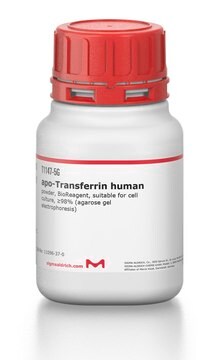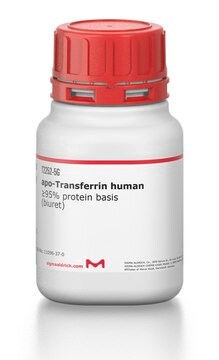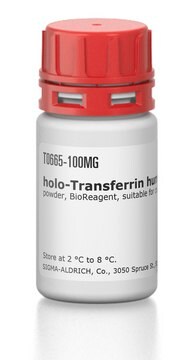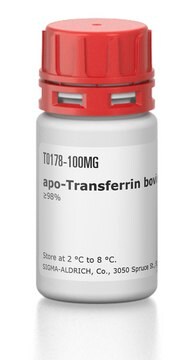T2036
apo-Transferrin human
powder, BioReagent, suitable for cell culture, ≥98% (agarose gel electrophoresis)
Synonym(s):
Human transferrin, Siderophilin
About This Item
Recommended Products
product line
BioReagent
Quality Level
Assay
≥98% (agarose gel electrophoresis)
form
powder
mol wt
76-81 kDa
concentration
~25 mM
technique(s)
cell culture | mammalian: suitable
impurities
HIV and HBsAg, source material tested negative
endotoxin, tested
solubility
H2O: 50 mg/mL
cation traces
Fe: ≤0.005%
UniProt accession no.
shipped in
ambient
storage temp.
−20°C
Gene Information
human ... TF(7018)
Looking for similar products? Visit Product Comparison Guide
General description
Application
- to culture human primary pancreatic endothelial cells, Het1As (non-tumorous esophagus cells), and immortalized human colonic epithelial cells (HCEC-1CT)
- to culture α mouse liver 12 (AML-12) (mature hepatocytes) cells
- as a source for human apo-transferrin for purification before crystallography
Biochem/physiol Actions
Other Notes
Disclaimer
Storage Class Code
11 - Combustible Solids
WGK
WGK 3
Certificates of Analysis (COA)
Search for Certificates of Analysis (COA) by entering the products Lot/Batch Number. Lot and Batch Numbers can be found on a product’s label following the words ‘Lot’ or ‘Batch’.
Already Own This Product?
Find documentation for the products that you have recently purchased in the Document Library.
Customers Also Viewed
Related Content
Our team of scientists has experience in all areas of research including Life Science, Material Science, Chemical Synthesis, Chromatography, Analytical and many others.
Contact Technical Service












